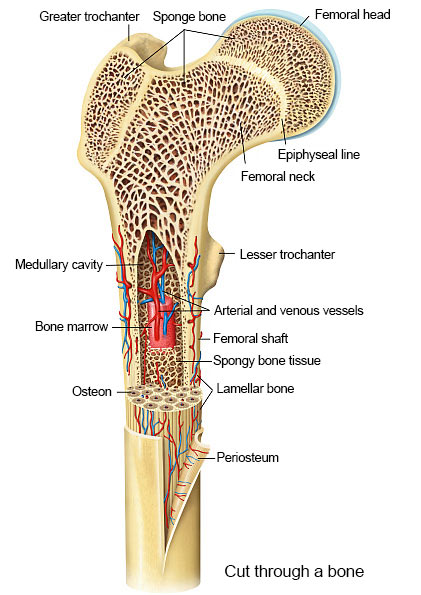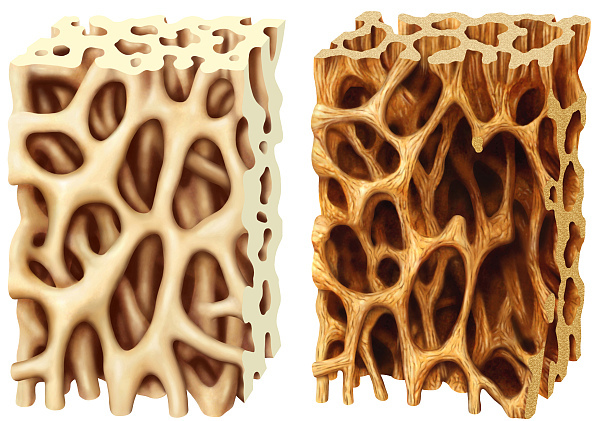Bones
Structure and Function
Bone is a complex tissue with multiple functions. It consists of different cell types that are embedded in a matrix of organic and inorganic compounds. The bones give a body its shape, they enable directed movement, and protect internal organs. They also play a role in the body’s mineral balance and contain bone marrow which is crucial for blood production (hematopoiesis) [Scheinpflug et al. 2018].
There are two different types of bones, cortical and trabecular (spongy) bones, both of which are based on a framework of collagen fibrils. Cortical bone is very dense and strictly organized, while trabecular bone has a honeycomb structure of trabeculae. Cortical bone is resistant to bending and torsional forces, while the trabecular structure offers mechanical flexibility [Scheinpflug et al. 2018]. Both, bone density (mineral content) and bone microarchitecture determine the stability of a bone [Goolsby, Boniquit 2017].
Osteoblasts are bone-forming cells that build up the organic components of bones through the synthesis of type I collagen. The organic components are mineralized with calcium salts, predominantly in the form of hydroxyapatite. In parallel, osteoblasts either differentiate into osteocytes or cover the bone surface as bone lining cells. Osteocytes serve, among other things, as mechanical stress sensors and control the remodeling process of the bone. Osteoclasts, in contrast, are bone-degrading cells [Scheinpflug et al. 2018].
Remodeling of Bones
Bones constitute a dynamic tissue that is subject to lifelong remodeling [Goolsby, Boniquit 2017]. Damaged or aged bone material is replaced by new tissue which enables the adaptation of a bone to mechanical stress. The process of remodeling is strictly regulated and depends on bone factors and hormones. About 5 to 10% of the skeleton is remodeled each year [Walsh 2015]. Remodeling also plays an important role in the healing of bone fractures. To link the two parts of a broken bone, a less structured woven bone with low mechanical strength is formed. Later on, this structure is replaced by a more resilient lamellar bone [Walsh 2015].
Remodeling plays a key role in bone health. Unbalanced formation and degradation of bone tissue leads to diseases such as stress fractures, osteopenia, or osteoporosis.
Effects of Diet, Exercise, and Age on Bone Health
Despite some contradictory results of clinical studies, a protein-rich diet is considered beneficial for the maintenance of bone mass, provided that an adequate supply of calcium is given [Rizzoli, Bonjour 2004, Calvez et al. 2012, O’Keefe et al. 2018]. As protein, in particular animal protein, is considered anabolic for bones and muscles, high protein intake is recommended to maintain bone health. Since a protein-rich diet increases calcium excretion via the kidneys, concerns have been raised about a negative effect on bone density. However, it could be shown that the increased excretion of calcium is not due to calcium mobilization from bones, but due to an increased calcium intake from food [Calvez et al. 2012]. Meat, fish, dairy products, as well as protein from grains lead to an increased acid load in the body. This is attributed to sulfur-containing amino acids such as methionine and cysteine, which are metabolized to sulfate in the body. Protein sources with a low sulfur-containing amino acid content may be favorable for supplementation to ensure high protein intake [Thorpe et al. 2008]. In addition, the acid load can be reduced by an increased consumption of fruits and vegetables [Thorpe et al. 2008]. Collagen protein, in turn, has a low content of sulfur-containing amino acids combined with a high content of collagen-forming amino acids. Those may be beneficial for supplementation, as long as a sufficient supply of methionine is guaranteed. Notably, other nutrients such as magnesium, and the vitamins C, D, and K are important for healthy bones as well [O’Keefe et al. 2016, Karpouzos et al. 2017]. A diet that corresponds to the evolutionary heritage of humankind appears to be beneficial not only in terms of bone quality, but also for muscles and physical fitness [Frassetto et al. 2001].
Mechanical stress is crucial for the formation and protection of bone mass and strength. Or, seen from another perspective, lacking stress on bones and muscles (e.g., during bed rest) will rather quickly result in bone resorption and loss of bone quality. Although bones are able to regenerate after resuming physical activity, this process takes time. Beneficial activities include running, climbing stairs, dancing, and tennis, which burden the bones with full body weight, but also activities that promote endurance, like swimming or cycling, have a beneficial effect by strengthening the muscles. Notably, there should always be enough time between peak loads for the bones to regenerate [Goolsby, Boniquit 2017].
Bone density reaches its peak in early adulthood which significantly contributes to bone health in old age. The basis for bone density is laid by an appropriate supply of nutrients and sufficient physical activity in childhood and adolescence. From the age of 50 on, bone tissue turnover and bone degradation increase [Walsh 2015, O’Keefe et al. 2018] and certain medications, such as corticosteroids, are also known to accelerate loss of healthy bone tissue. In any case, the formation of healthy bones in adolescence is especially important for women, who go through hormone-induced loss of bone mass after menopause [Goolsby, Boniquit 2017]. However, bone loss can be counteracted by a reasonable diet and appropriate physical activity.
Effects of Bioactive Collagen Peptides on Bones
Experiments in several models revealed a positive effect of collagen peptides on the structure and mineralization of bones [Daneault et al. 2017]. Collagen peptides supply amino acids that are important for collagen formation in the body. If they are administered in certain peptide formulations, the development and differentiation of osteoblasts is promoted, whereas the formation of osteoclasts is decreased [Elango et al. 2018]. In addition, collagen peptides seem to improve the absorption of calcium and also have anti-inflammatory and antioxidant properties [Daneaultet al. 2017]. All of these findings support a positive effect of collagen peptides on bone health, although results still have to be reviewed in clinical studies in humans.
Clinical Studies
By now, only a few studies have been published that investigated the direct effect of collagen peptides on bone formation; most of them being carried out in combination with other active substances [Daneault et al. 2017].
König and coworkers published a prospective, randomized double-blind study to investigate the effect of Bioactive Collagen Peptides on bone density and bone biomarkers in postmenopausal women with a reduced bone density [König et al. 2018]. The study included 131 women who received 5 g Bioactive Collagen Peptides (66 women) or 5 g maltodextrin as a placebo (65 women) daily for 12 months. At the beginning and the end of the study, a medical examination was carried out, the bone density of the femoral neck and the lower lumbar spine were measured, and blood samples were taken to determine biomarkers and assess any adverse effects. At the same time, data on the participant’s diet and activity was collected. After 12 months, a statistically significant increase in bone density was detected in the verum group, both in the spine and the femoral neck, while the placebo group showed a decrease in those parameters. After adjustment to group differences, the bone density had increased by 4.2% and 7.7% in the spine and femoral neck, respectively, compared to the placebo group. In addition, biomarkers revealed an anabolic effect of Bioactive Collagen Peptides. The evaluation of blood count, liver and kidney values, and inflammation parameters did not reveal any adverse effects, and no patient discontinued the therapy due to side effects.
Last update: July 2022

